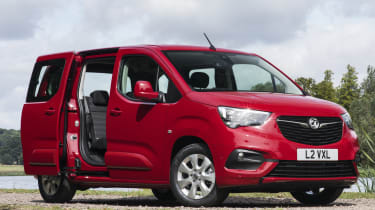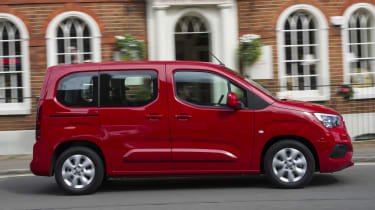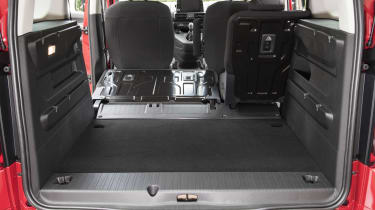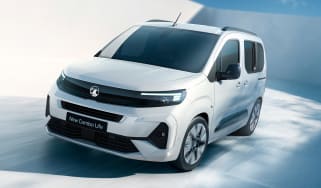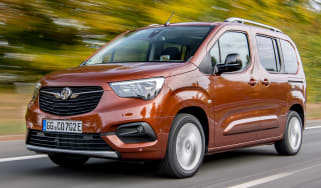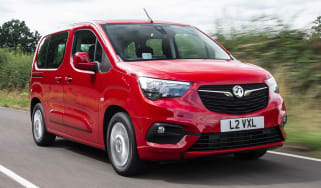Vauxhall Combo Life review: MPV that's low on charisma, high on utility
The Vauxhall Combo Life is unashamedly a van-based MPV, delivering practical, flexible and cost-effective family transport

Don’t deride the box-like styling of the Vauxhall Combo Life. After all, we’ve already found the no-nonsense Vauxhall Combo van to be one of the best of its kind to move whatever you want, and this passenger version is no less versatile.
You can get so much into this vehicle, including up to seven people, meaning it has just as many seats as the most giant SUVs, but it doesn’t have the bulk of those vehicles, so running costs are much more like a regular, less practical family hatchback. Okay, so the set-square styling isn’t going to win you many admiring glances, and it isn’t the most engaging thing to drive, but to focus on such superficialities is to miss the point of this car.
About the Vauxhall Combo Life
The Vauxhall Combo Life is a van-based people carrier that is essentially the replacement for the discontinued Vauxhall Zafira, and is based on a shared platform with the Peugeot Rifter and Citroen Berlingo. The Combo Life will appeal to those who need greater practicality than the Vauxhall Crossland, or Grandland SUVs can provide.
Fundamentally, the Combo Life is the same car as the Rifter and Berlingo, just with a different nose, a mildly reworked dashboard area and trim levels that align with the rest of the Vauxhall range.
Used - available now

2020 Vauxhall
Combo Life
60,941 milesManualPetrol1.2L
Cash £8,577
2021 Vauxhall
Combo Life
13,605 milesAutomaticPetrol1.2L
Cash £16,565
2022 Vauxhall
Combo Life
22,843 milesAutomaticPetrol1.2L
Cash £16,490
2022 Vauxhall
Combo Life
43,768 milesAutomaticPetrol1.2L
Cash £16,795You can order the Combo Life in standard five-seat and seven-seat XL lengths. In standard form, the boot offers between 597 litres and 2,126 litres of luggage capacity, but this extends to between 850 litres and 2,693 litres in the long-wheelbase Combo Life XL.
The focus is on the all-electric version that joined the range in 2021 and is called the Vauxhall Combo-e Life. The fully electric version uses the same 50kWh battery as the Vauxhall Corsa Electric and Vauxhall Mokka Electric and manages up to 174 miles. It’s available with five seats in standard wheelbase form, or seven seats in longer XL form.
Motability customers looking to convert the vehicle for wheelchair ramp access can specially order a traditional diesel version. The 1.5-litre turbodiesel engine is sourced from the Stellantis group. It comes only in Design trim and is available in five and seven-seat forms, with two power outputs (99bhp or 128bhp), and either a six-speed manual gearbox as standard, or an eight-speed automatic transmission for the higher-powered diesel.
Prices start at just under £21,500 for a 1.5-litre diesel in Design trim, with the seven-seater XL starting at just shy of £23,000 – or nearly £3,500 more than our favourite affordable seven-seater, the Dacia Jogger. There’s a bit of a jump up from the more powerful diesel automatic into the equivalent electric Combo-e Life, going from a little over £26,000, all the way up to a little over £34,000. The seven-seat electric version in range-topping Ultimate (Ultimate trim is only available with the electric model) rounds out the range at nearly £37,000.
Entry-level design trim includes rear parking sensors, twin sliding doors, an eight-inch infotainment system with digital radio and Apple CarPlay and Android Auto connectivity, plus 16-inch alloy wheels. Head further up the range to Ultimate for a reversing camera, sat-nav, and two-zone air conditioning as standard.
Vauxhall has done little to disguise the Combo Life’s van-based roots, which, for some buyers, will make a welcome change from the over-styled and overly complex SUVs of the world. Other rivals include the Berlingo, Rifter, Ford Tourneo Connect, and Volkswagen Caddy.
Dismissing the Vauxhall Combo Life as a poor relation in the platform-sharing venture would be easy. The French duo look more attractive, while the Rifter offers a far more exciting cabin. But look beyond the humdrum styling, and you’ll find a refreshingly honest MPV, offering a tremendous amount of space for up to seven people with a high degree of versatility. The driving experience is predictably van-like, but the Combo Life appears to have been pitched perfectly for those who want to get from A to B and aren’t too fussed about what happens in between.
Engines, performance and drive
Few people will be expecting to read about an MPV that’s fun to drive and fizzing with excitement. So, in this respect, the Vauxhall Combo Life doesn’t disappoint. With van-like dimensions, a tall stance and a range of economy-led engines, this vehicle isn’t designed to delight.
Keep the Combo Life within its comfort zone, and it’ll repay you with a smooth ride and relaxed manners – two attributes that are particularly prominent when driving long distances and on the motorway. It’s a shame that a fair amount of wind noise tends to blot the Combo Life’s copybook when driving at motorway speeds.
Aside from that, the diesel engine drops to a relaxed hush at speed. Naturally, the electric motor in the Combo-e Life provides a much quieter drive around town with no engine noise, although there is a little motor whine at motorway speeds. The eight-speed automatic transmission suits the Combo Life’s laid-back approach, so the auto would be our choice. The manual gearbox is vague and nowhere near as slick as the manual gear change provided in the Ford Tourneo Connect.
Predictably, there’s a fair amount of lean if you drive with enthusiasm, while the car’s tendency to understeer means you’re unlikely to push the Combo Life hard into a corner more than once. There’s minimal feel or feedback in the Combo Life because its steering is very light and barely feels connected to the front wheels. The Tourneo Connect provides superior steering weight, and we feel a little more confident carrying speed down a twisty B road in it than in a Combo Life.
The brakes of the standard Combo Life feel strong enough to cope safely with a carload of people and their luggage. The Combo-e Life comes with two levels of regenerative braking; utilise the ‘B’ mode on the gear selector to put it in its strongest setting, and you’ll slow down more quickly than its default setting after lifting off the accelerator, allowing you to drive with one pedal most of the time.
Engines, 0-60 acceleration and top speed
Provided you keep the Combo-e Life in its ‘Power’ driving mode, you’ll uncork the full 136bhp, providing a 0-62mph time of 11.7 seconds. Leaving it in Normal mode will rein the powertrain back to (107bhp) in the interests of maximising range, although that’s still enough to keep up with the traffic flow. The top speed is just 84mph, although that’s more than enough for UK roads.
For those looking at the Combo Life as a wheelchair conversion vehicle, the cheapest 99bhp 1.5-litre diesel is the slowest version with a 0-62mph in just under 13 seconds, and you can expect the heavier long-wheelbase XL version to be even more sluggish. We reckon you might be better off going for the more powerful 129bhp 1.5-litre diesel because it is swifter (0-62mph takes 10.6 seconds), and it’ll cope better with any heavy ramp equipment you’ll need to have installed.
MPG, CO2 and Running Costs
With commonly used engines, the Vauxhall Combo Life delivers fuel economy numbers similar to its Berlingo and Rifter kin. The only difference is that, unlike with the Berlingo, you can’t have a petrol Combo Life.
The 99bhp1.5-litre diesel in six-speed manual form offers the best fuel economy of the range at 53.3mpg. The more powerful 128bhp model comes exclusively with an eight-speed manual, which drops the fuel economy to 45.5mpg. These are all fine figures, but the Ford Tourneo Connect and the VW Caddy diesel models do better, with high 50s economy numbers.
Likewise, the Tourneo Connect and Caddy emit less CO2, so you’ll pay less initial road tax (VED). However, neither has an ace-in-the-hole electric version for company car drivers, which is where the Combo-e Life comes in. Its exemption from road tax (VED) until 2025 and 2% Benefit-in-Kind (BiK) company car tax rate means running one will be significantly cheaper.
The Combo-e Life hides a 50kWh (47kWh useable) battery under the floor, providing a driving range of 174 miles. True, there are alternatives, such as the VW ID. Buzz that’ll go further thanks to a larger 77kWh battery pack, but that costs considerably more.
Regarding rapid charging, the Combo-e’s 100kW maximum charging speed means a 10-80% top-up will take around 30 minutes from a suitably quick rapid charger. Alternatively, a 7kWh home wallbox can refill a flat battery in eight hours.
Insurance groups
The Combo Life starts in insurance group 10 for the 99bhp 1.5-litre diesel Design, and goes up to group 21 for the electric Combo-e Ultimate XL seven-seater. That’s on par with the Berlingo range, but the VW Caddy will likely be cheaper to insure because it starts in group eight before topping out in group 12.
Depreciation
According to our residual value experts, the Vauxhall Combo Life (specifically, the electric Combo-e Life we have data for) is expected to hold on to 46-48 per cent of its value after three years or 36,000 miles. That’s a little better than the equivalent e-Berlingo range but behind the e-Rifter, which is a little more desirable and will maintain 50-52 per cent of its value.
To get an accurate valuation on a specific model check out our free car valuation tool...
Interior, design and technology
You’d struggle to call any of the MPV trio from Peugeot, Citroën and Vauxhall attractive, but Combo Life has been dealt the weakest hand in the styling department. Little has been done to disguise the van roots, and the standard Vauxhall grille makes the Combo Life look, at best, rather plain, especially when compared with the rugged-looking Peugeot Rifter. The Vauxhall ‘Vizor’ styling that’s being applied to the facelifted Combo Life cannot come soon enough.
The Peugeot looks marginally more premium, while the Berlingo looks part of the Citroen family, thanks partly to its exterior's ‘Airbump’ panels. Whether the Vauxhall’s ‘runt of the litter’ styling will matter to the target audience is up to you.
The same theme continues on the inside. While the cabin is functional and fit for purpose, it lacks flair and imagination. Again, the Rifter has the most eye-catching cabin, thanks to the i-Cockpit layout with the dials above the small steering wheel. In the Combo Life, you get a layout similar to the Citroen Berlingo, with the dials behind a conventionally sized steering wheel. Some buyers might prefer this more traditional look.
The dashboard area consists of a sea of grey plastics and hard surfaces. It’s neither easy on the eye nor inspiring, which is perhaps why so many people prefer the more car-like ambience of an SUV. At least the main touch points are similar to those found in the rest of the Vauxhall range. The steering wheel, gear lever and column stalks are the same as used in the Astra or Grandland, and help differentiate the Combo Life from the Berlingo. However, you’ll only notice the difference if you try both models back-to-back.
Some drivers will like the raised gear lever in manual versions – we just wish the knob itself was nicer to use and not as chunky. The seats of the standard Design trim offer little support, so you’ll need to step up to Ultimate trim to get manually adjustable lumbar support for a little extra comfort.
In fact, there isn’t much scope to add any luxuries, unlike rivals such as the Ford Tourneo Connect and VW Caddy. Apart from being able to specify sat-nav, a tow bar, and a spare wheel, you’re left with having to upgrade to Ultimate trim to get additional luxuries such as a heated leather-covered steering wheel. Oddly, heated seats aren’t an option, so you’ll need to go for the rivals mentioned above in order to get this welcome feature in winter.
Sat-nav, stereo and infotainment
All Combo Life models come with an 8.0-inch touchscreen that features Apple CarPlay and Android Auto, along with DAB digital radio, Bluetooth, USB audio connection, and six speakers.
Upgrading to Vauxhall’s Multimedia Navi Pro system brings a sat nav system with a 3D view and European mapping, plus the Connect system that adds emergency assistance, live traffic and online features. It’s standard on electric models but optional on the diesel versions.
The sound system is okay, but – in our experience – you’ll need to crank up the volume on motorway trips to overcome the road and wind noise at speed.
Practicality, comfort and boot space
Space and practicality are the main focus points of cars such as the Vauxhall Combo Life, and fortunately, it doesn’t disappoint. Whether you opt for the 4.4-metre standard version or the 4.75-metre long Combo Life XL, you’ll find an enormous amount of space for passengers and their luggage inside.
The standard version has five seats, while the longer XL has seven seats. Every version has sliding rear doors on both sides, which should make getting people into the back easier in a car park (and mean those getting out don’t accidentally hit other cars). Curiously, the Combo Life isn’t quite as slick inside as the Citroën Berlingo (especially in Flair XTR trim) and Peugeot Rifter, with many of the brighter trim colours and fancier finishes found in the French versions entirely missing from the Vauxhall, making it the dullest looking of the three inside.
The Combo Life also misses out on some of the neat storage solutions available in its French alternatives, such as the aircraft-style storage locker that drops down from the ceiling above the boot, or the floating, translucent overhead panel that runs along the roof with additional reading lights and storage for small items.
There’s no arguing, though, that the Combo Life has the edge over many SUVs of a similar price – particularly from a practicality point of view. You get a high driving position, and the big windows provide excellent visibility. It’s easy to judge where the corners of the car are thanks to its slab sides and vertical rear end. You get rear parking sensors as standard to help with parking, while a reversing camera is standard on top-of-the-range Ultimate.
Size
The standard Combo Life measures 4,403mm long, while the Combo Life XL is 4,753mm long, with the extra length behind the third row of seats. This means you get a huge boot, which we’ll come to in a moment.
All models are 1,921mm wide (2,107mm, including door mirrors). The standard Combo Life sits 1,841mm tall, with the XL version adding a further 39mm in height.
For comparison, the Volkswagen Caddy (and its Ford Tourneo Connect sibling) is longer at 4,500mm (4,853mm in Maxi or Grand Tourneo forms), but a little narrower at 1,855mm (2,100mm including mirrors).
Leg room, head room & passenger space
Each seat offers plenty of space, with the light and airy cabin accentuating the sense of roominess. Adults over six-foot should find more rear leg room in the Combo Life than a Dacia Jogger, which can be a little tight for the taller folk. On the five-seat models, the second-row seats are split 60/40, while Ultimate trim and all seven-seat XL versions allow them to be folded individually, delivering even more flexibility.
The third row of seats on the seven-seat XL can be removed to create a cavernous load area.
Two ISOFIX points are provided on the outer second-row positions on five-seat models with the 60/40 split, while the individual sliding rear seats on Ultimate and seven-seat XL models have ISOFIX across all three positions, allowing for the fitment of three child seats.
Boot
The boot size is impressive, regardless of the model in question. In standard guise, there’s 597 litres of luggage capacity, which extends to 2,126 litres with the passenger seats folded down.
In the Combo Life XL, this extends to a minimum of 806 litres, with a huge 2,693 litres available with all seats folded away or removed. In contrast, a Jogger only has 160 litres of space with the third row up, and 1807 litres with all seats folded.
All Combo Life models have a low bumper height, making it an ideal car for those with dogs because it’ll be easier for them to get in and out. The tailgate is enormous and difficult to open in a tight car parking bay. This has been thought of because every Combo Life has an opening glass window for you to load up the boot without having to open the whole tailgate.
Towing
The braked towing capacity ranges from 750kg for the electric version, up to 1,500kg for a shorter five seat model with the most powerful diesel engine. A removable tow bar with a 13-pin connector can cost as much as £600, but for that money, it will include a trailer stability programme integrated into the ESP system.
If you’re looking to tow bigger caravans or trailers, you’ll need to get an SUV, or look at even larger van-based MPVs, such as the Citroën Spacetourer diesel, which can pull up to 1,900kg.
Reliability and Safety
While the Vauxhall Combo Life (or its siblings) didn’t feature in the most recent Driver Power owner satisfaction survey, the Vauxhall brand ranked 24th out of 32 manufacturers. That puts it above fellow van-based MPV and seven-seat car manufacturers Dacia, VW, and Ford, but behind Citroën and Peugeot.
The Combo Life received a four-star Euro NCAP crash test rating in 2018. The result was based on the rating for the mechanically similar Peugeot Rifter. Newer rivals, such as the Ford Tourneo Connect and VW Caddy have passed the latest and most stringent tests and managed a full five stars out of five. The Rifter and Combo were criticised for not protecting the head of vulnerable road users, an autonomous emergency braking system that couldn’t recognise cyclists, and a lack of a seat belt reminder for the optional third-row seats – the latter being amongst the reasons why the Dacia Jogger received such a low NCAP score.
The Combo Life comes with the driver-assistance features we expect in more conventional family cars, such as autonomous emergency braking (AEB), lane-keeping assistance, and automatic high-beam assistance. Rear parking sensors are also standard - handy given the Combo Life’s size. It’s a shame that additional safety aids like blind spot warning aren’t available, because that’s a standard feature on the mid-range Expression Jogger. It’s also quite annoying that an alarm isn’t standard either, and costs an additional £200.
Warranty
Every new Vauxhall comes with a three-year/60,000-mile warranty. Extended warranties are available after the manufacturer’s warranty has expired. The battery on Combo Life Electric models is covered if it drops below 70% capacity in the first eight years or 100,000 miles.
Servicing
The diesel Combo Life will require a service every 12 months or 20,000 miles, whichever comes first. Owners can spread the cost of servicing by paying for the Vauxhall Service Club, which, amongst other things, offers 15 per cent off accessories, half price MOTs, fixed price AdBlue refills, and a discount of up to 25 per cent on servicing and repairs. It also has a timing belt that needs changing every 10 years or 120,000 miles.
The Combo Life Electric needs an initial service after one year or 12,500 miles, whichever comes soonest, then it’ll need to be serviced every two years or 25,000 miles from that point onwards



